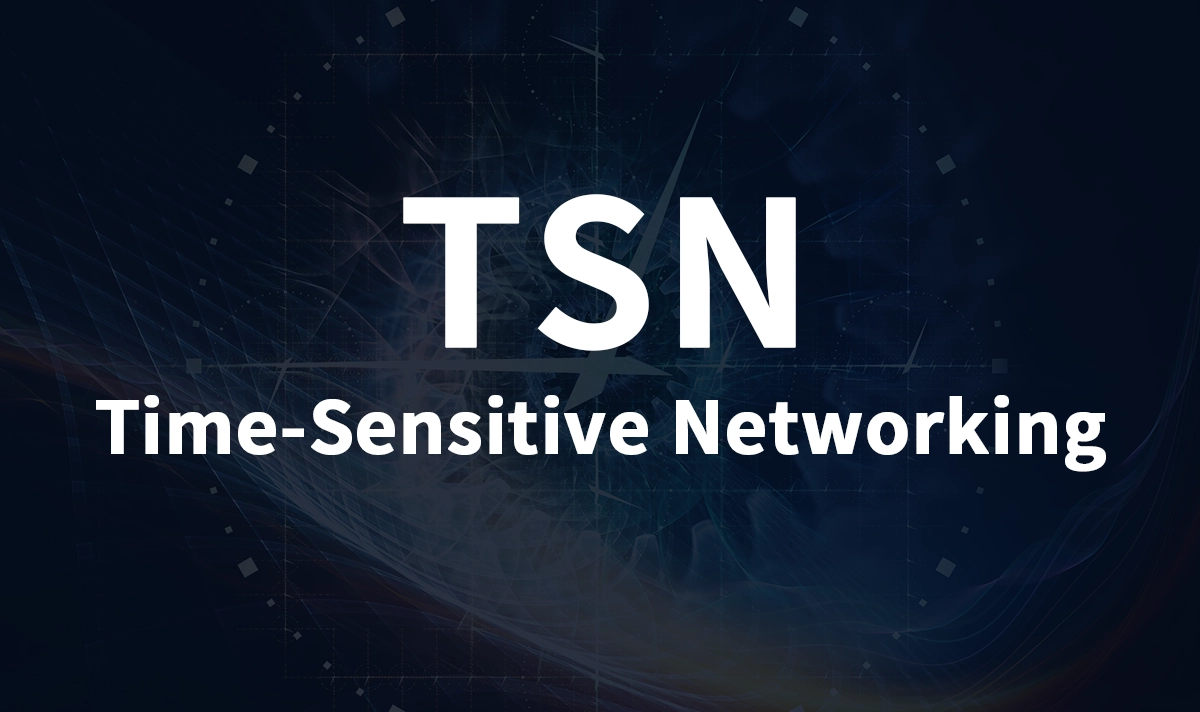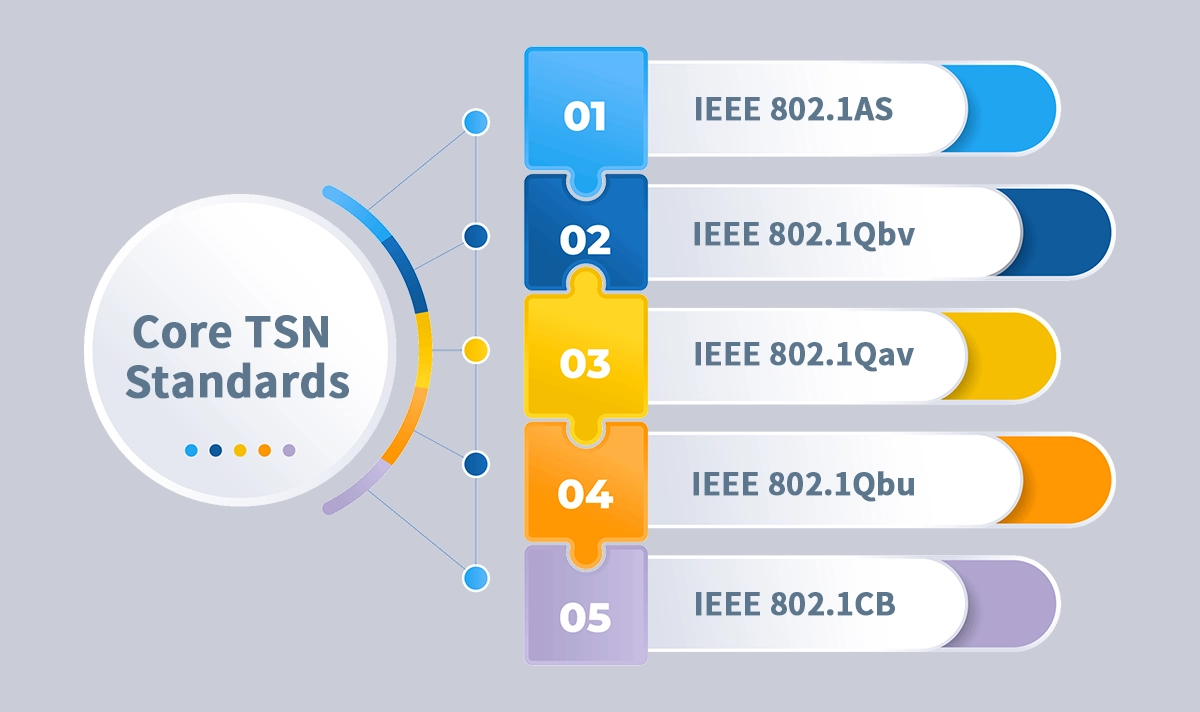
❶ Introduction: What Is Time-Sensitive Networking (TSN)?
Time-Sensitive Networking (TSN) is a collection of IEEE 802.1 standards that enhance standard Ethernet with deterministic, low-latency, and highly reliable data transmission.
In traditional Ethernet, data packets can experience unpredictable delays due to network congestion or queuing. TSN eliminates this uncertainty by ensuring that critical data is delivered on time, every time, even in complex, converged networks.
This makes TSN the backbone technology for smart factories, autonomous vehicles, and real-time industrial control systems where milliseconds—and even microseconds—matter.
❷ Why TSN Matters
TSN transforms conventional Ethernet into a deterministic communication platform, allowing time-critical and best-effort traffic to share the same network without interference.
Key Applications
Industrial Automation & Industry 4.0: TSN replaces traditional fieldbus systems, enabling synchronized communication between PLCs, robots, and sensors.
Automotive Ethernet: Essential for advanced driver-assistance systems (ADAS) and autonomous driving, where sensor data and control commands must be transmitted with minimal delay.
Professional Audio/Video (AVB): Provides precise time alignment and seamless media streaming across large installations.
By offering bounded latency, precise synchronization, and zero packet loss, TSN ensures consistent performance for mission-critical communication.
❸ Core TSN Standards and Features

1. IEEE 802.1AS — Precise Time Synchronization
The foundation of TSN is time synchronization. IEEE 802.1AS (gPTP) ensures that every device in the network shares a common sense of time—often accurate to within microseconds—enabling perfectly scheduled transmissions.
2. IEEE 802.1Qbv — Time-Aware Shaper (TAS)
TAS divides time into fixed cycles and assigns transmission windows to high-priority traffic. This scheduling guarantees that control messages are delivered predictably, even under heavy load.
3. IEEE 802.1Qav / 802.1Qcr — Traffic Shaping
Credit-Based and Asynchronous Traffic Shapers manage traffic flow and reduce congestion, ensuring smooth coexistence between real-time and best-effort data streams.
4. IEEE 802.1Qbu / 802.3br — Frame Preemption
Frame Preemption allows urgent data packets to interrupt ongoing low-priority transmissions, significantly reducing worst-case latency for critical flows.
5. IEEE 802.1CB / 802.1Qca — Redundancy and Path Control
These standards add frame replication, path redundancy, and stream reservation mechanisms, ensuring fault tolerance and guaranteed delivery even in the case of link or device failure.
❹ TSN in Practice: Network Design and Interoperability
In real-world applications, TSN can be configured either centrally (through a network controller) or decentrally (via Stream Reservation Protocols). Centralized configuration simplifies large-scale deployment and allows unified control over scheduling and bandwidth allocation.
To ensure cross-vendor compatibility, industry alliances such as Avnu Alliance and OPC Foundation promote TSN profiles and certification programs. For example, OPC UA over TSN combines deterministic Ethernet with standardized industrial communication, paving the way for fully integrated Industry 4.0 ecosystems.
❺ Performance and Engineering Considerations
Determinism vs Utilization: While time-aware shaping ensures microsecond-level latency, it requires careful scheduling to prevent bandwidth underutilization.
Multi-Hop Latency: Each TSN-enabled switch introduces predictable delay, allowing precise end-to-end timing analysis and network modeling.
Fault Tolerance: Redundant paths and frame replication enhance reliability for critical control systems and automotive safety networks.
❻ How LINK-PP Products Support TSN Networks
LINK-PP provides a wide range of Ethernet magnetic connectors, RJ45 Magjacks, and optical transceivers that support the bandwidth and signal integrity requirements for TSN-enabled industrial and automotive networks.
Our components ensure low jitter, high EMI resistance, and long-term reliability, making them ideal for time-critical communication in PLC systems, factory automation, and automotive ECUs.
For example:
LINK-PP Industrial RJ45 Connectors — designed for rugged, high-speed communication in Industry 4.0 environments.
LINK-PP Optical Modules — offering reliable high-bandwidth data transmission for TSN-based backbone networks.
By integrating TSN-ready components from LINK-PP, manufacturers can build future-proof Ethernet infrastructure that meets global standards for reliability and real-time performance.
❻ Implementation Checklist for Engineers
Identify the required TSN feature set (time sync, TAS, preemption, redundancy).
Verify hardware support in switches, NICs, and PHYs.
Conduct end-to-end testing with representative traffic patterns.
Use certified devices and standardized profiles for interoperability.
Design redundancy and failure recovery mechanisms for critical applications.
❼ Conclusion
TSN represents the next evolution of Ethernet — transforming it from a best-effort protocol into a deterministic, reliable, and synchronized communication platform. It enables industries to converge IT and OT networks, simplifying architectures while meeting the stringent timing demands of modern automation and intelligent transport systems.
With high-performance TSN-ready connectivity components, LINK-PP empowers customers to build smarter, faster, and more synchronized networks for the future of Industry 4.0 and connected mobility.


